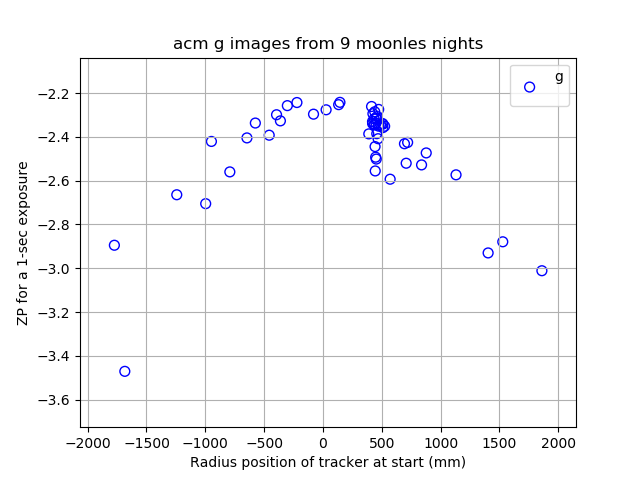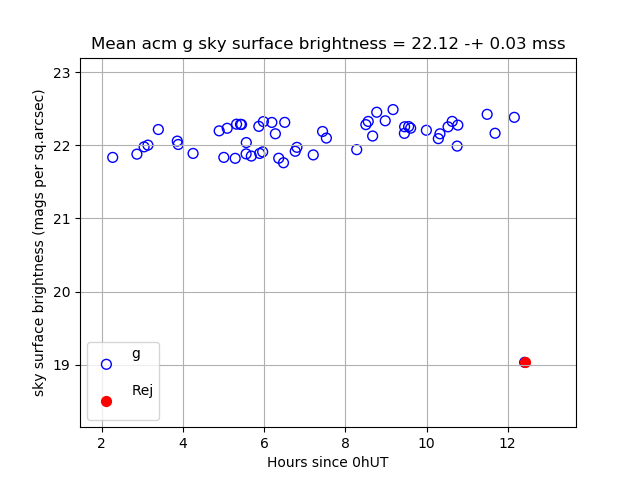I have assembled 71 reduced acm images in /home/sco/acm_SBSKY. These are
from 9 nights during the periods around new moon in Feb,Mar,Apr of 2019.
I am seeing that during these periods, where we observed primarily hetdex fiedld,
the acm images are primarily g filter observations. The few i images seem to be taken outside
the 18 degree twilight window.
Here I want to concentrate on building a script that sets up the initial g,i tables.
Then I want to make plots and compute stats witj various table/plotter tools in
oder to investigate systematics in the g image data.
The images are in: /home/sco/acm_SBSKY (see list.0)
I do analysis 02 in: /home/sco/acm_reds_sco2019/Analyses/Analysis02
% ls -1 /home/sco/acm_SBSKY/*fits > list.02
I make a table file with fits2table. Here is the PARAMS The PARAMSfile is
what determine what will be assembled i the table files.
% cat PARAMS
WAVELEN Filter wavelength (angs)
UTHOURS Hours since 0hUT
UTDATE UT date (YYYYMMDD)
RSTRT Radius position of tracker at start (mm)
AZHET HET structure AZ (deg)
MILLUM percentage moon illumination
PHIMOON angle of separation to moon (deg)
ZPSEC ZP for a 1-sec exposure
ZPERR mean error of ZPSEC
SKYSB sky surface brightness (mags per sq.arcsec)
SKYSBERR mean error of SKYSB
To get tables:
% ACM_ANALYSIS_TABLES list.02 PARAMS N
Make a nice plot:
% Generic_Points N # edit "xyplotter_auto.pars"
% xyplotter_auto datg RSTRT ZPSEC 20 N # edir List.20 , Axes.20 hereafter
% xyplotter_auto dati RSTRT ZPSEC 20 N # edir List.20 , Axes.20 hereafter
Using the datg table:
% point_selector datg RSTRT ZPSEC N
I view (and record) afe bad points. These were:
/home/sco/acm_SBSKY/20190401T092839.5_acm_sci.fits
/home/sco/acm_SBSKY/20190205T121618.8_acm_sci.fits
/home/sco/acm_SBSKY/20190204T024712.6_acm_sci.fits
/home/sco/acm_SBSKY/20190204T103114.8_acm_sci.fits
/home/sco/acm_SBSKY/20190307T081109.3_acm_sci.fits
/home/sco/acm_SBSKY/20190207T073956.7_acm_sci.fits
I remove these from datg.images to make: list.02_cleaned_g
Then I make a new datg table:
% ACM_ANALYSIS_TABLES list.02_cleaned_g PARAMS N
% point_selector datg RSTRT ZPSEC N # there is a bug here!!!!!
Now I see a clean plot, so I use xyplotter_auto:
% xyplotter_auto datg RSTRT ZPSEC 10 N
% xyplotter_auto datg UTHOURS SKYSB 20 N
*** I see one bad poin
% point_selector datg UTHOURS SKYSB N # mark the bad point
% point_selector_stats.sh xyf.in Y 0 N
22.12446 22.16460 0.19432 0.02669 53 (mean,mediam,sig,me,n)
Hence, excluding the one bad point taken after 12h UT the mean
g sky surface brightness is 22.12 -+ 0.03
I put thsi in the Axes.20 file and replot with:
% xyplotter List.20 Axes.20 N
Basic results are illustrated below.

